This post contains affiliate links. If you click through and make a purchase, we may earn a commission at no additional cost to you. Thank you for your support
Thank you for reading this post, don't forget to subscribe!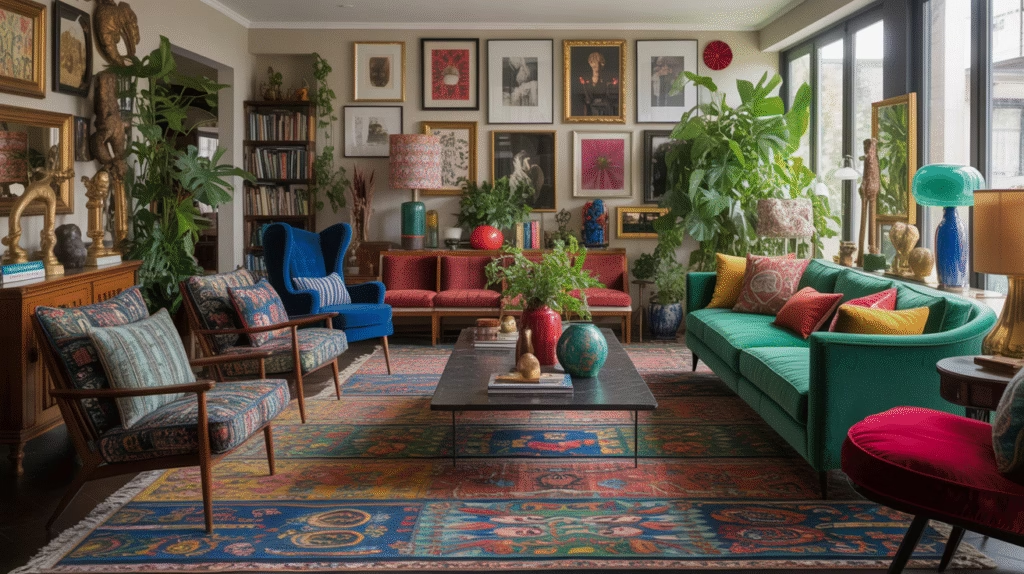
Welcome to the vibrant, unapologetic world of maximalist home decor—where “more is more” isn’t just a motto, it’s a celebration of personality, passion, and creative freedom. If you’ve ever felt constrained by the stark simplicity of minimalism or longed to surround yourself with colors, patterns, and objects that spark joy, maximalism might be your design destiny.
This comprehensive guide will walk you through everything you need to know about creating a maximalist home that feels intentional, cohesive, and uniquely yours—not cluttered or chaotic. Whether you’re a design novice or a seasoned decorator looking to embrace a bolder aesthetic, you’ll discover the principles, elements, and strategies that make maximalism work beautifully in any space.
Understanding Maximalism: More Than Just “More”
Maximalism is often misunderstood as simply cramming as many items as possible into a room. In reality, it’s a sophisticated design philosophy rooted in intentional curation and personal storytelling. Emerging as a counter-movement to the minimalist trend that dominated the 2010s, maximalism draws inspiration from historical design periods like Victorian opulence, Art Deco glamour, and Bohemian eclecticism.
At its core, maximalism is about creating spaces that reflect who you are—your travels, passions, collections, and memories. It embraces abundance, but with purpose. Every item should have a reason for being there, whether it brings you joy, tells a story, or contributes to the overall aesthetic harmony of the space.
Maximalism vs. Minimalism: Finding Your Design Philosophy
The debate between maximalism and minimalism isn’t about which is “better”—it’s about which aligns with your lifestyle, personality, and psychological needs. Minimalism offers calm, clarity, and reduced visual clutter, which can lower stress and enhance focus. It’s ideal for those who find peace in simplicity and prefer clean lines and open spaces.
Maximalism, conversely, provides emotional stimulation, creative expression, and a sense of comfort through abundance. Research shows that personalized, vibrant spaces can boost mood and evoke joy, making maximalism particularly appealing for creative individuals who thrive in visually rich environments.
Interestingly, 2025 has seen the rise of “minimalist maximalism” or “midimalism”—a hybrid approach that combines the structural clarity of minimalism with the personality and boldness of maximalism. This middle ground allows you to enjoy the best of both worlds: a curated, organized foundation with expressive, colorful accents.
Core Principles of Successful Maximalist Design
Before diving into specific elements, it’s crucial to understand the foundational principles that prevent maximalism from descending into chaos:
1. Cohesive Color Palette
While maximalism celebrates bold colors, successful spaces maintain a unifying color thread. Choose 2-4 dominant colors that repeat throughout the room or home, creating visual flow. These might be jewel tones like emerald green, sapphire blue, and ruby red, or you might opt for a palette inspired by nature, vintage textiles, or a favorite piece of art.
The key is repetition: if you have a bold pink throw pillow, echo that pink in artwork, a rug, or decorative accessories. This creates intentional cohesion rather than random chaos.
2. Varied Scale and Proportion
One of the biggest mistakes in maximalist decorating is using too many small objects. Instead, vary the scale of your items—pair large statement pieces with medium and small accessories. This creates visual hierarchy and gives the eye places to rest.
For example, a large piece of artwork or an oversized mirror can anchor a gallery wall of smaller frames, while a substantial floor lamp balances a collection of tabletop accessories.
3. Intentional Curation
Maximalism isn’t about keeping everything you own visible. It’s about thoughtfully selecting items that contribute to your space’s story. Edit ruthlessly—if something doesn’t bring you joy or fit your aesthetic vision, store it or let it go.
Think of your space as a curated collection, like a museum exhibit of your life. Each piece should have significance, whether sentimental or aesthetic.
4. Balance and Breathing Room
Even in maximalist spaces, negative space matters. Leave some surfaces clear, create breathing room between furniture pieces, and ensure pathways remain functional. Strategic use of symmetry—like matching lamps on either side of a sofa—can create calm amid the visual abundance.
Getting Started: Your Maximalist Journey
If you’re transitioning from minimalism or simply want to embrace a bolder aesthetic, start small and build gradually. Here’s how:
Start with One Room
Rather than overwhelming yourself, designate one room as your maximalist laboratory. Powder rooms, entryways, or home offices are excellent starting points—they’re smaller spaces where bold choices won’t feel overwhelming, allowing you to experiment before committing to larger areas.
Build Around a Statement Piece
Begin with one item you absolutely love—a vibrant piece of art, an heirloom rug, or a bold piece of furniture. Let this anchor piece dictate your color palette and style direction. Build your room around it, adding complementary items that enhance rather than compete with your focal point.
Add Layers Gradually
Maximalism is a “go-slow” process. Add layers over time: start with paint or wallpaper, then furniture, textiles, artwork, and finally accessories. This gradual approach allows you to assess what works and prevents impulse decisions that might not fit your evolving vision.
10 Essential Elements of Maximalist Home Decor
Now let’s explore the specific elements that make maximalist spaces sing. Each of these components contributes to the rich, layered aesthetic that defines the style:
1. Bold, Saturated Color Palettes
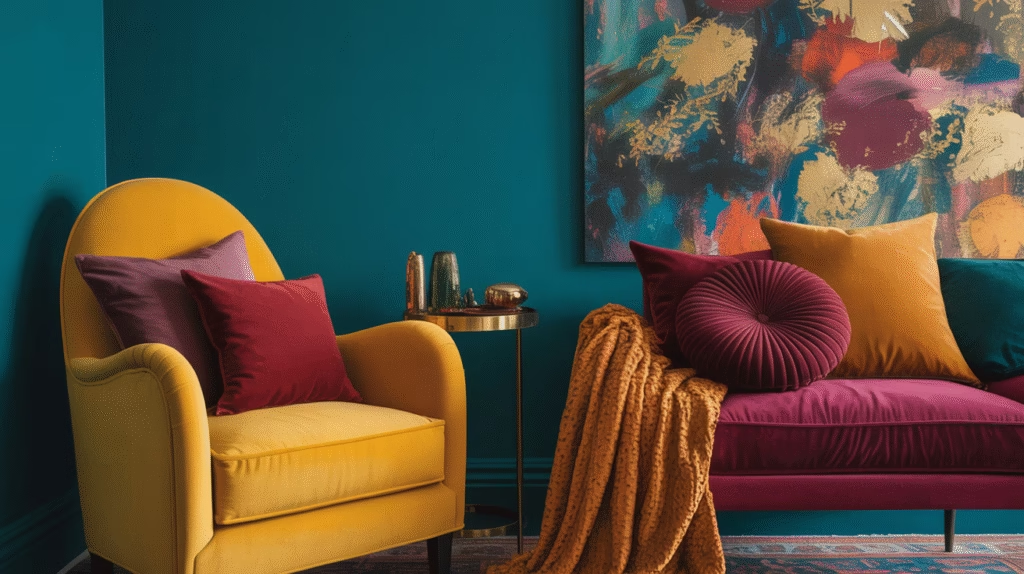
Color is the heartbeat of maximalist design. Move beyond safe neutrals and embrace rich, saturated hues that make statements. Think deep emerald greens, royal blues, burnt oranges, and mustard yellows. These colors can appear on walls, furniture, textiles, or accessories.
How to Implement: Start with a feature wall in a bold color or invest in a statement sofa in a jewel tone. If painting seems too permanent, use removable wallpaper in vibrant patterns or introduce color through large textiles like curtains and rugs. Remember to echo your chosen colors throughout the space for cohesion—if you paint one wall deep teal, incorporate teal accents in artwork, throw pillows, or decorative objects.
Expert Tip: Don’t be afraid of dark colors in small spaces. When used wall-to-wall, deep hues can create a cozy “jewel box” effect that feels intentional and luxurious rather than cramped.
2. Eclectic, Layered Wall Art
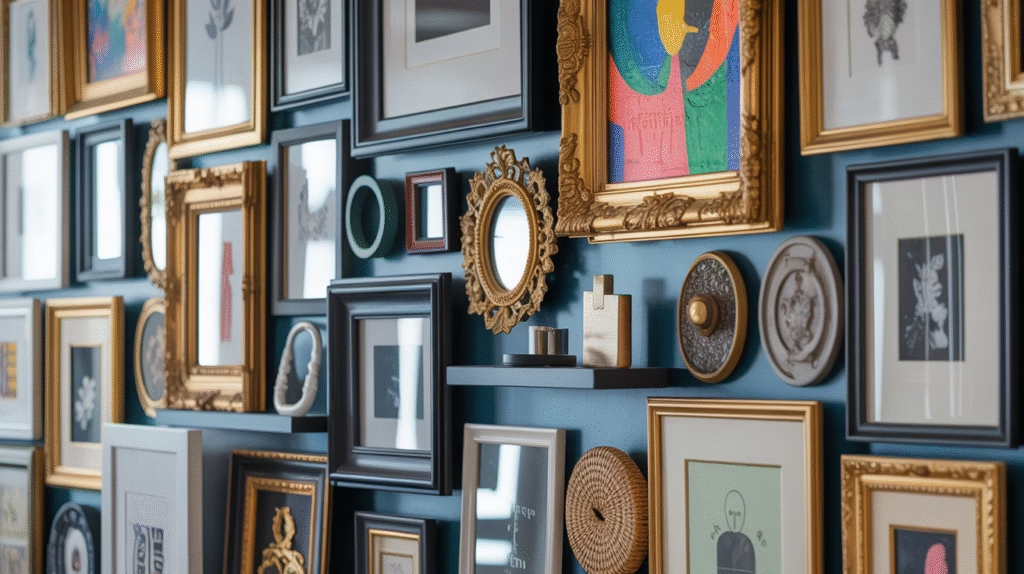
Gallery walls are maximalism’s signature feature, but they require strategy to avoid looking cluttered. The goal is to create a cohesive collection that tells a visual story, mixing different frame styles, artwork mediums, and sizes.
How to Implement: Start by laying out your gallery wall on the floor to experiment with arrangements before committing to wall holes. Mix family photos with abstract paintings, vintage prints with contemporary photography. Use a variety of frame materials—wood, metal, ornate gold—but maintain some unifying element, whether it’s a consistent mat color or a balanced arrangement style.
Expert Tip: Don’t stop at traditional framed art. Incorporate three-dimensional elements like woven baskets, mirrors, or small shelves to add depth and texture. The key is creating different “visual weights” that balance each other out.
3. Statement Furniture with Personality
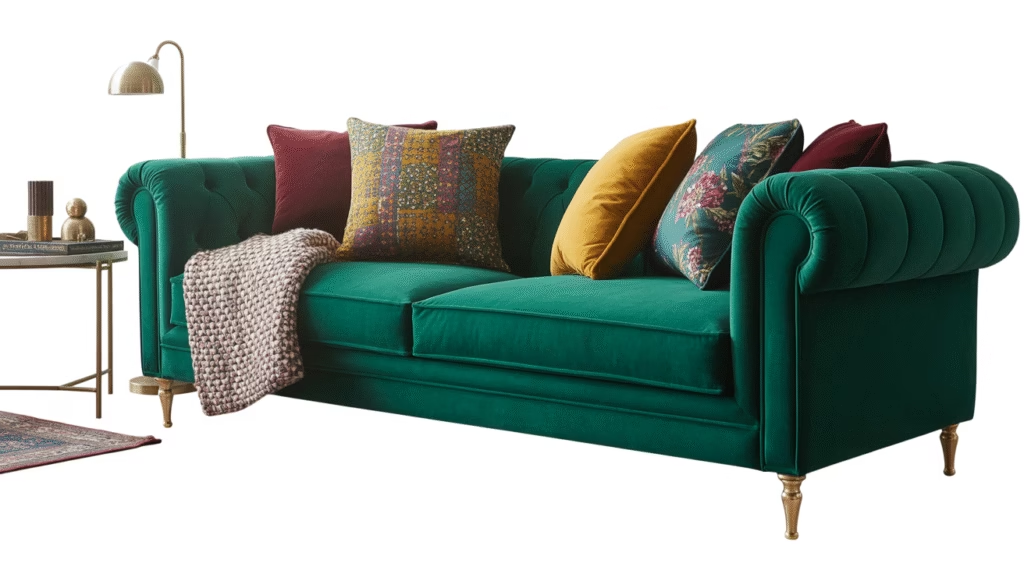
Maximalist spaces thrive on furniture that commands attention. Look for pieces with unique silhouettes, bold upholstery, or distinctive details like turned legs, carved wood, or brass hardware.
How to Implement: Invest in one or two major statement pieces per room. This might be a velvet Chesterfield sofa in a surprising color, a vintage dresser with ornate hardware, or a sculptural coffee table that doubles as art. Mix furniture styles and eras—pair a mid-century modern chair with a Victorian side table. This eclectic approach adds visual interest and tells a richer story than perfectly matched furniture sets.
Expert Tip: Don’t worry about everything being “practical.” Maximalism celebrates pieces that are chosen for their beauty and character, even if they’re slightly impractical. That stunning but delicate antique chair? Display it proudly, even if it’s more decorative than functional.
4. Layered Textures and Textiles
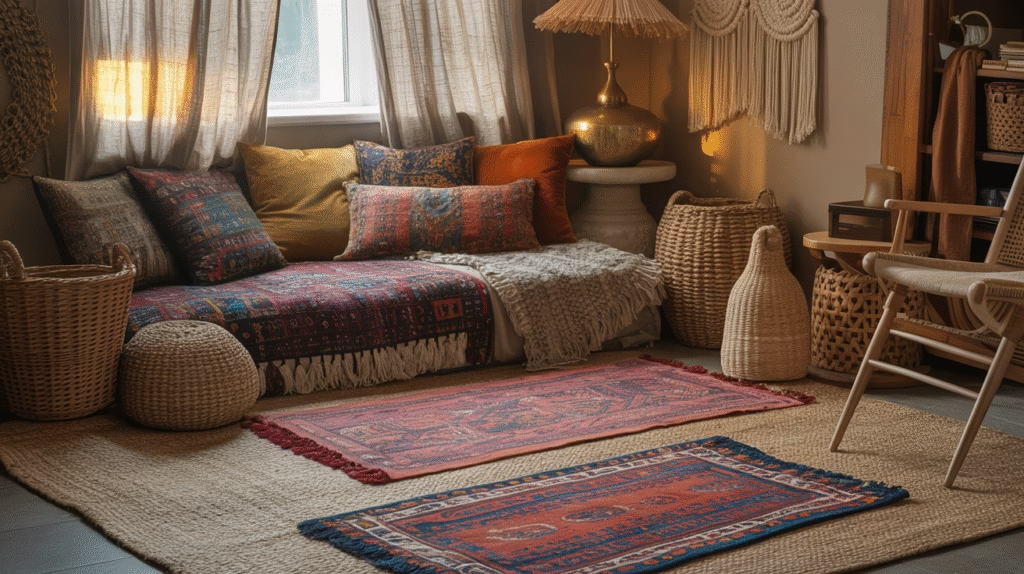
Texture is what transforms a visually busy space into one that feels rich and inviting rather than overwhelming. Layer different materials to create tactile interest that complements your visual abundance.
How to Implement: Think beyond just visual elements to incorporate touch. Layer rugs (yes, you can place a smaller patterned rug over a larger neutral one), drape throws over furniture, and pile cushions in varying fabrics—velvet, silk, wool, linen, and cotton. Mix smooth surfaces with rough ones, shiny with matte, soft with structured.
Expert Tip: Natural textures like jute, rattan, and wood ground maximalist spaces, preventing them from feeling too precious or staged. Incorporate these organic elements through baskets, furniture, or decorative objects to add warmth and accessibility.
5. Fearless Pattern Mixing
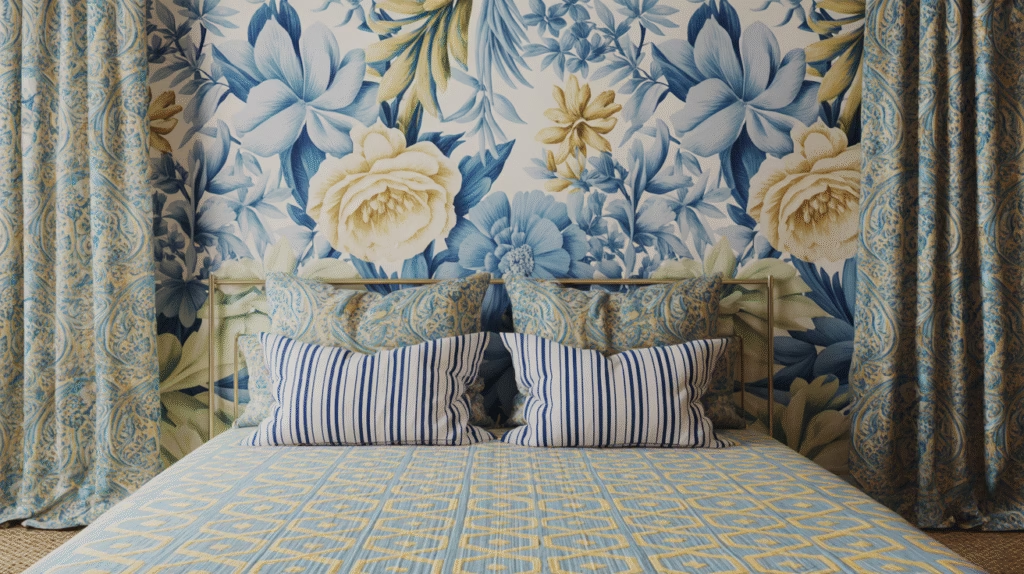
Pattern is where maximalism truly shines, but it’s also where things can go wrong without a strategy. The secret to successful pattern mixing is varying scales and maintaining color consistency.
How to Implement: Choose patterns in different scales—pair large-scale florals with small geometric prints, or mix bold stripes with delicate paisleys. Keep them connected through a shared color palette. For example, if you’re mixing patterns in blues and yellows, ensure that shade of blue repeats across different patterns rather than using navy in one and sky blue in another.
You can introduce patterns through wallpaper, upholstery, curtains, rugs, and throw pillows. Start conservatively with two patterns and gradually add more as you become comfortable.
Expert Tip: “Pattern drenching”—covering walls, ceiling, and even furniture in coordinating patterns—is a hot maximalist trend for 2025. While bold, it creates a cohesive, immersive environment when done with careful color coordination.
6. Vintage and Antique Treasures

Incorporating vintage and antique pieces adds depth, history, and soul to maximalist spaces. These items carry stories and craftsmanship that new pieces often lack, making your space feel collected over time rather than decorated overnight.
How to Implement: Haunt flea markets, estate sales, and antique shops for unique finds. Look for items with patina, interesting shapes, or historical significance. Vintage mirrors, antique lamps, retro furniture, or old books all add character. Don’t worry about matching wood tones or eras—maximalism celebrates the mix.
Expert Tip: Blend vintage pieces with contemporary ones to prevent your space from feeling like a museum. A modern sofa paired with an antique coffee table creates dynamic tension that’s more interesting than an all-vintage or all-new room.
7. Abundant Plants and Greenery
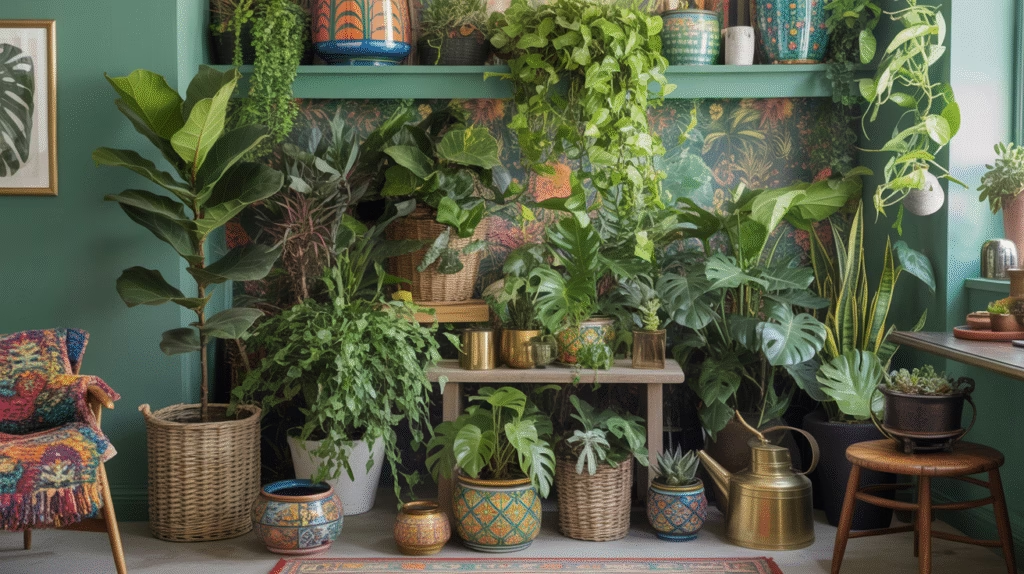
Living plants bring life, texture, and air-purifying benefits to maximalist spaces. They also provide a unifying element of natural green that complements virtually any color palette.
How to Implement: Create plant collections in varying heights and pot styles. Mix large floor plants like fiddle leaf figs or monstera with trailing plants like pothos, and smaller tabletop succulents. Group plants together for impact, or place individual specimens throughout the room as living sculptures. Choose decorative pots that contribute to your aesthetic—colorful ceramics, woven baskets, or vintage brass planters all add to the maximalist vibe.
Expert Tip: If you lack a green thumb, high-quality faux plants have come a long way and can provide the visual impact without maintenance. Mix them with a few real, hardy plants for authenticity.
8. Unique Accessories and Collections
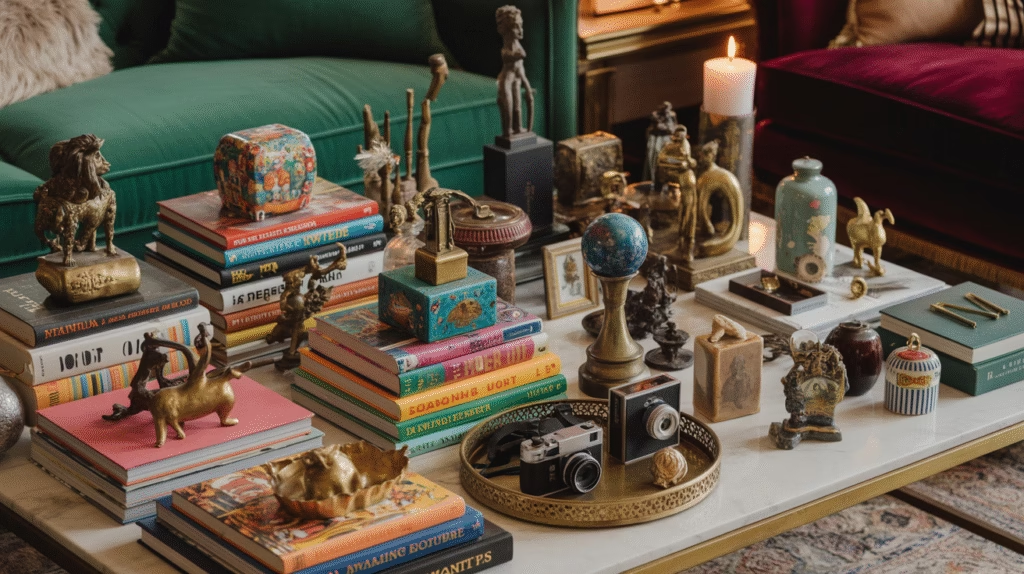
Accessories are where personality truly shines in maximalist design. Display your collections—whether books, ceramics, vintage cameras, or travel souvenirs—as part of your decor.
How to Implement: Group collections rather than scattering them throughout the room. Use the “rule of three” (or five, or seven—odd numbers create visual interest) when arranging objects. Create vignettes on surfaces like coffee tables, shelves, and mantels by layering items of different heights and textures.
Coffee table books, decorative boxes, candles, sculptures, and interesting found objects all contribute to a curated, maximalist look.
Expert Tip: Use trays to corral smaller items and create boundaries within your displays. This prevents collections from looking cluttered and makes surfaces easier to clean.
9. Dramatic Wall Treatments
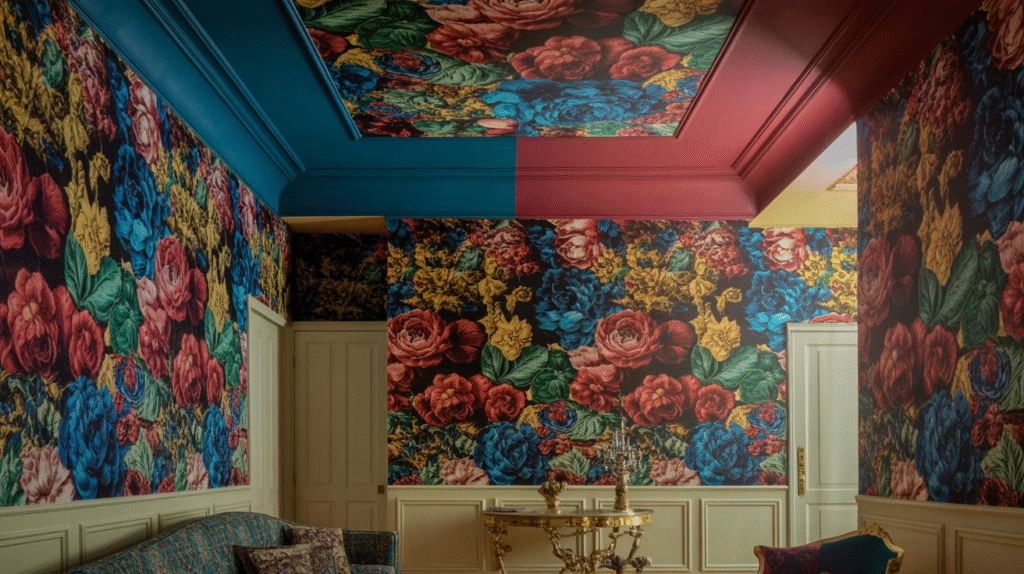
Maximalist walls deserve special attention. Move beyond flat paint to incorporate wallpaper, wall paneling, murals, or even unconventional materials like fabric or wood.
How to Implement: Bold wallpaper is a maximalist staple—choose large-scale florals, dramatic damasks, or vibrant geometric prints. If wallpapering entire rooms feels overwhelming, create an accent wall or use it in smaller spaces like closets, bathrooms, or powder rooms.
Consider alternatives like board and batten paneling painted in rich colors, exposed brick, or reclaimed wood treatments for added texture and interest.
Expert Tip: Don’t forget the “fifth wall”—your ceiling. Painted ceilings, ceiling wallpaper, or decorative molding add unexpected visual interest and make rooms feel more complete.
10. Mix of Design Styles and Eras

Maximalism celebrates eclecticism, welcoming the blend of different design styles, periods, and cultural influences. This mixing prevents spaces from feeling too themed or one-note.
How to Implement: Intentionally pair contrasting styles—mid-century modern with Victorian, industrial with romantic, bohemian with Art Deco. The key is finding common threads that tie disparate pieces together, whether through color, material, or scale.
For example, you might pair a sleek mid-century credenza with an ornate antique mirror above it, unified by a similar wood tone or shared color in surrounding decor.
Expert Tip: Research traditionally compatible style combinations if you’re nervous about mixing. Boho pairs well with coastal, industrial complements rustic, and mid-century modern flows nicely with Scandinavian elements.
Common Maximalist Mistakes to Avoid
Even experienced decorators can stumble when embracing maximalism. Avoid these pitfalls:
Too Many Colors Without Cohesion
Using every color in your palette without a unifying thread creates visual chaos. Stick to a consistent color scheme and repeat those colors throughout your space.
Over-Accessorizing with Small Items
Hundreds of tiny knickknacks create clutter, not curated charm. Focus on fewer, larger statement pieces complemented by carefully edited collections of smaller items.
Ignoring Scale and Proportion
All small items or all large items both create imbalance. Vary the scale of your decor for visual hierarchy and interest.
Neglecting Negative Space
Even maximalist rooms need breathing room. Leave some surfaces clear and maintain functional pathways between furniture.
Mixing Too Many Patterns Without Strategy
Random pattern combinations can clash. Vary pattern scales and maintain color consistency to create harmony.
Forgetting About Room Flow
Each room should connect to the next with some unifying element—whether a repeated color, pattern, or style—to prevent your home from feeling disjointed.
Tips for Achieving Balance in Maximalist Spaces
Creating a successful maximalist room requires striking the right balance between abundance and order:
Use a Neutral Base: Ground bold elements with neutral floors, ceilings, or larger furniture pieces. This creates calm amid the visual excitement.
Create Focal Points: Every room needs a primary focal point that anchors the space. This might be a fireplace, a piece of art, or statement furniture. Let other elements support rather than compete with it.
Edit Regularly: Maximalism is not “set it and forget it.” Regularly assess your space, rotate accessories seasonally, and remove items that no longer serve your vision.
Incorporate Symmetry: Strategic symmetry—matching lamps, paired artwork, or mirrored arrangements—creates order that balances asymmetrical, eclectic elements.
Mind the Lighting: Proper lighting showcases your carefully curated decor. Use layered lighting—ambient, task, and accent—to highlight different elements and create ambiance.
Maintain Functionality: Beauty shouldn’t sacrifice livability. Ensure your space remains functional with clear pathways, comfortable seating, and adequate storage.
Conclusion: Embracing Your Maximalist Journey
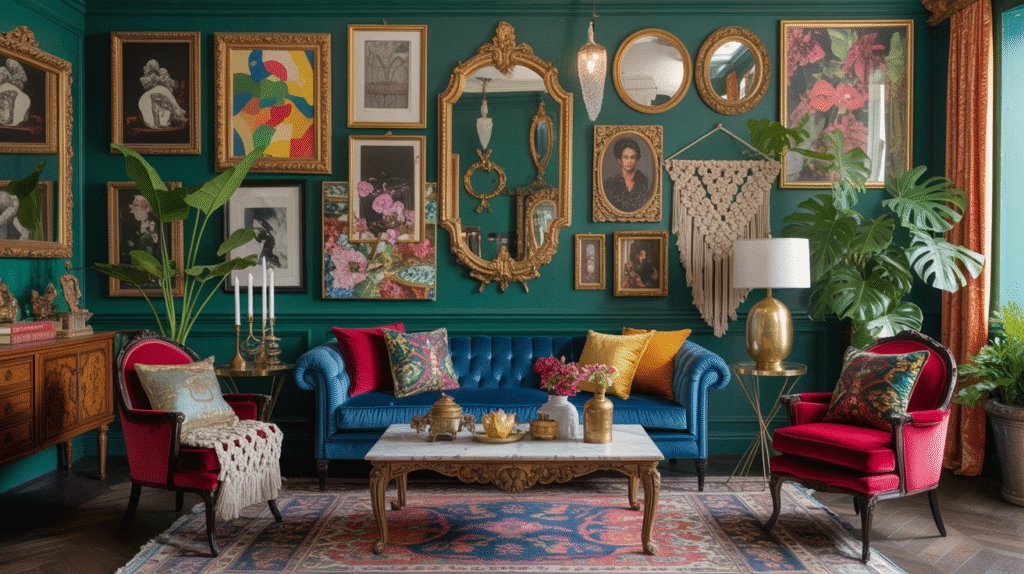
Maximalist home decor is ultimately about creating spaces that feel authentically you—spaces that energize, inspire, and bring joy every time you enter them. Unlike trends that come and go, maximalism is a timeless approach to design that celebrates individuality and personal expression.
Remember that there’s no “right” way to do maximalism. Your maximalist space should reflect your unique tastes, experiences, and personality. Start small, build gradually, and don’t be afraid to experiment. The beauty of maximalism is its forgiving nature—if something doesn’t work, you can adjust, move things around, or try something new.
Whether you go full maximalist throughout your home or create one vibrant, personality-packed room, embracing this design philosophy allows you to surround yourself with the colors, patterns, and objects that make you happy. And in our increasingly digital, minimalist world, there’s something profoundly satisfying about creating a physical space that’s rich, layered, and unapologetically bold.
So gather your favorite pieces, mix those patterns, layer those textures, and create a home that doesn’t just look good—it feels like you.